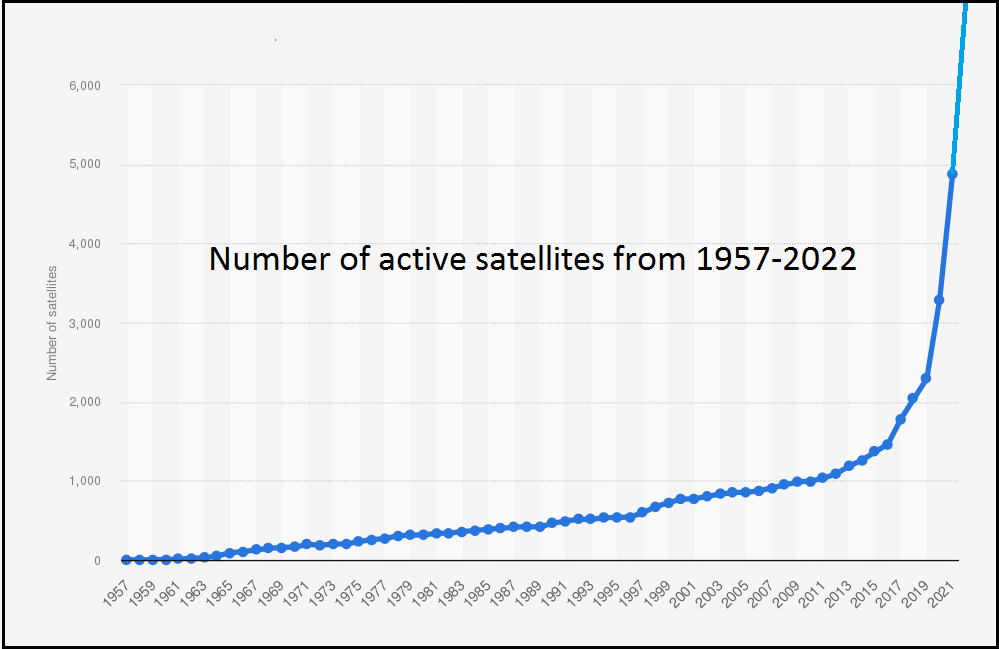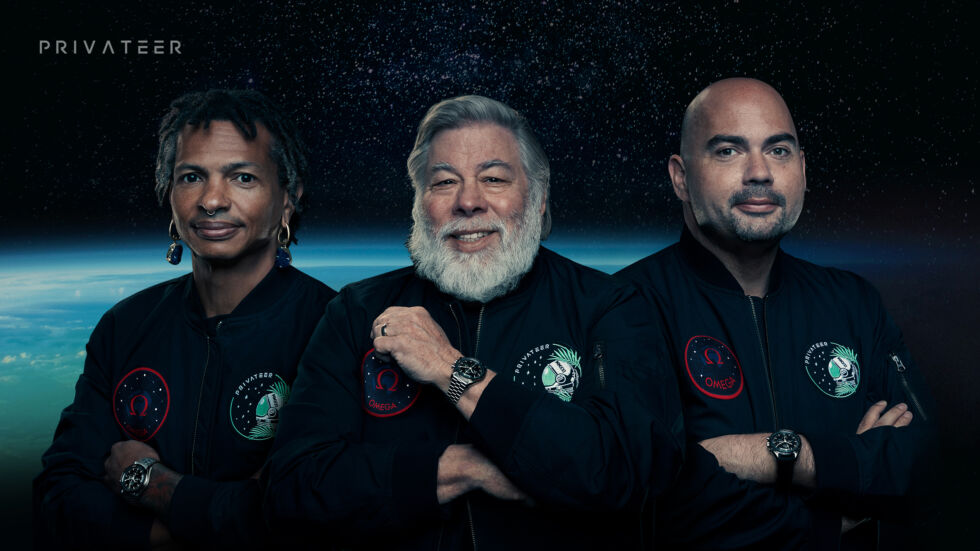
NUMBER OF OPERATING SATELLITES PASSES 7,000. Image source.
Comments by Brian Shilhavy
Editor, Health Impact News
The commercialization and militarization of space in the past couple of years has seen an explosion of satellites being sent into orbit, with literally tens of thousands of more satellites scheduled to be launched in the near future.
Besides the surveillance issues I have briefly touched upon in recent articles, what other potential consequences are there for launching so many satellites?
Since this is not my area of specialty, I am republishing two recent articles on this topic covering it from two different angles.
The first article is from Arthur Firstenberg, President of the Cellular Phone Task Force. I published an amazing article he wrote in 2020 about the efficacy of surgical face masks:
Studies of Surgical Masks Efficacy
Excerpt:
As a person who went to medical school, I was shocked when I read Neil Orr’s study, published in 1981 in the Annals of the Royal College of Surgeons of England.
Dr. Orr was a surgeon in the Severalls Surgical Unit in Colchester. And for six months, from March through August 1980, the surgeons and staff in that unit decided to see what would happen if they did not wear masks during surgeries.
They wore no masks for six months, and compared the rate of surgical wound infections from March through August 1980 with the rate of wound infections from March through August of the previous four years.
And they discovered, to their amazement, that when nobody wore masks during surgeries, the rate of wound infections was less than half what it was when everyone wore masks.
Their conclusion: “It would appear that minimum contamination can best be achieved by not wearing a mask at all” and that wearing a mask during surgery “is a standard procedure that could be abandoned.”
I was so amazed that I scoured the medical literature, sure that this was a fluke and that newer studies must show the utility of masks in preventing the spread of disease.
But to my surprise the medical literature for the past forty-five years has been consistent: masks are useless in preventing the spread of disease and, if anything, are unsanitary objects that themselves spread bacteria and viruses. (Full article.)
So even though face masks were not Firstenberg’s topic of specialty, this one was so well researched that it still stands in mind as one of the best articles published on the topic since the COVID Plandemic started.
The second article is by Eric Berger of Ars Technica about the amount of “Space debris” this is creating, and the negative consequences.
Ecocide from Space
by Arthur Firstenberg
Cellular Phone Task Force
On the evening of Thursday, December 8, 2022, OneWeb launched 40 satellites from Cape Canaveral, Florida, bringing the total number of active satellites in orbit around the Earth to more than 7,000. These cell towers in space are altering the electromagnetic environment of the entire planet and are debilitating and exterminating all life on it.
Even the first fleet of 28 military satellites launched by the United States caused a worldwide pandemic of influenza when they became operational on June 13, 1968. The Hong Kong flu began in June 1968, lasted through April 1970, and killed up to four million people worldwide.
To understand why requires a proper understanding of our connection to the universe and what it is that really gives us life and health, and makes our bodies move. In a sense, we are all puppets on invisible strings that connect us to heaven and earth, strings that resonate at the age-old frequencies of the biosphere in which we live, the space between Earth and Sky, whose dimensions never change. And when we modulate and pulsate those strings at random from thousands of locations in space, we change the beautiful music of the earthly orchestra into a discordant chaos that scatters bodies all over the world, helpless before it.
On March 24-25, 2021, the chaos was brought to a new level, that the world now accepts as normal. In that 24-hour period, a record 96 satellites were launched into space on a single day—60 by SpaceX and 36 by OneWeb—and on the same day SpaceX dramatically increased the speed of its satellite internet connections.
On that day, people all over the world suddenly could not sleep, were weak and exhausted, had muscle spasms, and hurt and itched all over, especially in their feet and legs. They had skin rashes, were dizzy and nauseous, and had stomach aches and diarrhea. The ringing in their ears was suddenly amplified. Their eyes were inflamed, and their vision suddenly worsened. They had heart arrhythmias, and their blood pressure went out of control. Some had nosebleeds, or coughed up blood. They were anxious, depressed or suicidal, and irritable. Their cats, dogs, chickens, goats and cows were sick at the same time.
My newsletter of April 15, 2021, Survey Results, quoted from some of the thousand letters I received from people young and old, from people who called themselves electrosensitive and from people who did not, from people who had no wireless technology and from people who had smart meters and 5G antennas outside their homes and who emailed me from their cell phones, all reporting the same experiences, commonly reporting that not only they, but their spouse, children, parents, neighbors, friends, coworkers, clients, and everyone else they knew were sick, exhausted and irritable on March 24 or 25 and had trouble sleeping. The reports came from 42 states and 50 countries.
Deaths of blue titmice spiked in Germany beginning on March 25, 2021. March 25 registered the second highest number of COVID-19 deaths in 2021, and the fifth highest since the pandemic began. The number of mass shootings in the US rose suddenly on March 25 and remained high for three weeks. An average of 6 shootings involving 4 or more victims occurred every day between March 25 and April 13. Photographs of hundreds of worms, and of hundreds of sheep, moving silently in perfect spirals, were taken on March 25 and March 26.
Long-term pain, sickness, and debility has become so common that it is now accepted as a normal part of life that the world thinks it can address with endless vaccinations, mask-wearing, and the wiping of all hands and surfaces with toxic disinfectants.
Last week, on December 8, 2022, on the day OneWeb launched satellites that will expand its coverage across the US, Europe, the Middle East and Asia, I experienced within my body, and heard from some other people both locally and far away that the pains and debilities from which we have been suffering at some level for the past 20 months suddenly intensified. I was almost crippled for three days. As on March 24-25, 2021, I would like to find out how widespread this is. Please reply to this email if you have experienced something similar.
Although SpaceX and OneWeb are (so far) building the largest fleets of Earth-destroying satellites, they are far from the only entities launching them. The 7,000 satellites presently operating were launched by governments or private companies of the following countries:
Algeria, Argentina, Australia, Austria, Azerbaijan, Bangladesh, Belarus, Belgium, Bolivia, Brazil, Bulgaria, Canada, Chile, China, Colombia, Czech Republic, Denmark, Ecuador, Egypt, European Space Agency, Estonia, Ethiopia, Finland, France, Germany, Greece, Hungary, India, Indonesia, Iran, Iraq, Israel, Italy, Japan, Jordan, Kazakhstan, Kuwait, Laos, Lithuania, Luxembourg, Malaysia, Mexico, Monaco, Morocco, Multinational, Nepal, Netherlands, New Zealand, Norway, Pakistan, Paraguay, Peru, Poland, Qatar, Russia, Saudi Arabia, Singapore, Slovenia, South Africa, South Korea, Spain, Sri Lanka, Sudan, Sweden, Switzerland, Taiwan, Thailand, Tunisia, Turkey, Turkmenistan, Ukraine, United Arab Emirates, United Kingdom, United States, Uruguay, Venezuela, Vietnam
And they were launched from the following spaceports:
Baikonur Cosmodrome (Kazakhstan)
Cape Canaveral (Florida, USA)
Dombarovsky Air Base (Russia)
Guiana Space Center (French Guiana)
Jiuquan Satellite Launch Center (Inner Mongolia, China)
Kodiak Launch Complex (Alaska, USA)
Kwajalein Island (Marshall Islands)
Naro Space Center (South Korea)
Pacific Ocean (from Odyssey Sea Launch vessel)
Palmachim Launch Complex (Israel)
Plesetsk Cosmodrome (Russia)
Rocket Lab Launch Complex 1 (New Zealand)
Satish Dhawan Space Centre (India)
Shahroud Missile Range (Iran)
Svobodny Cosmodrome (Russia)
Taiyuan Launch Center (China)
Tanegashima Space Center (Japan)
Uchinoura Space Center (Japan)
Vandenberg Air Force Base (California, USA)
Vostochny Cosmodrome (Russia)
Wallops Island Flight Facility (Virginia, USA)
Wenchang Satellite Launch Center (China)
Xichang Satellite Launch Center (China)
Yellow Sea (from a mobile sea platform)
Other Satellite News
European IRIS Satellites
The European Union just got into the act with its own program to provide high-speed broadband from space to all of Europe and Africa. On December 5, 2022, the Council of the EU and the European Parliament reached a provisional agreement to launch 170 new satellites called Infrastructure for Resilience, Interconnection and Security (IRIS). “This new component of the EU Space Programme will put an end to dead zones in Europe as well as the whole of Africa using the constellation’s North-South orbits through a resilient and ultra-secure space and ground-based system,” says the EU’s Space Program (EUSPA) website.
AST SpaceMobile
On September 10, 2022, AST SpaceMobile launched the largest, and probably the most powerful, commercial communications array ever put into space. It is the first of a planned fleet of 243 Bluebird satellites designed to connect directly with people’s existing mobile phones, no matter where on Earth they may be located. The size of its solar array — 64 square meters — is causing alarm among astronomers because it is as bright as the brightest stars during the hours after sunset and before sunrise.
So far AST SpaceMobile is working with Rakuten Mobile, AT&T, Bell Canada, Telecom Argentina, Africell, Liberty Latin America and Orange, for a potential customer base of 1.8 billion mobile phone subscribers.
The immensely powerful signals from the Bluebird satellites are also worrying radio astronomers, as well as human beings who are concerned for their well-being. The effective radiated power of each satellite, according to AST’s filings with the FCC, will be up to 83 million watts, and the exposure level at the surface of the earth from such beams, according to my calculations, will be up to 3 nanowatts per square centimeter, which is 100 times more radiation than what I am exposed to in my house in Santa Fe from the nearest cell towers.
“Every person should have the right to access cellular broadband, regardless of where they live or work. Our goal is to close the connectivity gaps that negatively impact billions of lives around the world,” said Abel Avellan, CEO of AST SpaceMobile.
We beg to differ, Mr. Avellan. Every person, every animal, and every plant should have the right to drink from the Earth’s natural frequencies, and not to be bombarded with artificial radiation from space.
Read the full article here.
Space debris expert: Orbits will be lost—and people will die—later this decade
“Flexing geopolitical muscles in space to harm others has already happened.”
Eric Berger
Ars Technica

Up until about a decade ago, an average of 80 to 100 satellites per year were launched into varying orbits. Some reentered Earth’s atmosphere quickly, while others will remain in orbit for decades.
This now seems quaint. In the last five years, driven largely by the rise of communications networks such as SpaceX’s Starlink and a proliferation of small satellites, the number of objects launched into space has increased dramatically.
In 2017, according to the United Nations Office for Outer Space Affairs, the annual number exceeded 300. By 2020, the annual number of objects launched exceeded 1,000 for the first time. This year, the total has already surpassed 2,000. With more broadband-from-space networks like Amazon’s Project Kuiper on the way, further growth can be expected.
This radically increasing number of satellites, most of which are orbiting within 1,000 km of the Earth’s surface, comes as low-Earth orbit is ever more cluttered with debris.
For example, just last month, a Chinese Long March 6A rocket’s upper stage unexpectedly broke apart after delivering its payload into orbit. There are now more than 300 pieces of trackable debris at an altitude from 500 to 1,000 km.
And in November 2021, Russia shot down its own Cosmos 1408 satellite, creating more than 1,000 fragments in orbit. NASA’s International Space Station still has to dodge this debris to this day.
At some point, the heavens above will reach a breaking point. Yes, space is big, but there is so much junk out there.
Scientists and engineers estimate that there are hundreds of thousands of pieces of orbital debris about the size of a blueberry that cannot be tracked. Given their velocities of many times the speed of sound, these small objects have the kinetic energy of a falling anvil. Then there are tens of thousands of pieces of trackable debris the size of a softball or larger that have the kinetic energy of a large bomb. While some of this debris gets dragged down into Earth’s atmosphere and burns up every day, humans are rapidly creating more of it.
To get a sense of this threat and how humans might clean up their act, Ars spoke with Moriba Jah, an astrodynamicist from the University of Texas at Austin. Jah is a superstar in the field of orbital debris and one of the foremost voices sounding the alarm about the rising tide of space junk and calling for humanity to preserve low-Earth orbit. He also serves as chief scientist for Privateer Space, a company he co-founded with Apple Computer co-founder Steve Wozniak to better collect and share debris tracking data.
This interview has been edited for clarity.
Sustainable or not?
Ars: Given what has happened over the last few years and what is expected to come, do you think the activity we’re seeing in low-Earth orbit is sustainable?
Moriba Jah: My opinion is that the answer is no, it’s not sustainable. Many people don’t like this whole “tragedy of the commons” thing, but that’s exactly what I think we’re on a present course for. Near-Earth orbital space is finite. We should be treating it like a finite resource. We should be managing it holistically across countries, with coordination and planning and these sorts of things. But we don’t do that.
I think it’s analogous to the early days of air traffic and even maritime and that sort of stuff. It’s like when you have a couple of boats that are coming into a place, it’s not a big deal. But when you have increased traffic, then that needs to get coordinated because everybody’s making decisions in the absence of knowing the decisions that others are making in that finite resource.
Ars: Is it possible to manage all of this traffic in low-Earth orbit?
Jah: Right now there is no coordination planning. Each country has plans in the absence of accounting for the other country’s plans. That’s part of the problem. So it doesn’t make sense. Like, if “Amberland” was the only country doing stuff in space, then maybe it’s fine. But that’s not the case. So you have more and more countries saying, “Hey, I have free and unhindered use of outer space. Nothing legally has me reporting to anybody because I’m a sovereign nation and I get to do whatever I want.” I mean, I think that’s stupid.
Ars: In the United States, right now, much of the regulation of satellite activity is conducted by the Federal Communications Commission. But it seems like they’re pretty pro-business, so they’re mostly permissive.
Jah: I’m also pro-business in space. The thing is the manner in which we do it. At the end of the day, based on international law codified in treaties and conventions from 1967 to 1972, liability for damage and harmful interference falls squarely on the shoulders of states party to the treaty. So governments are responsible, ultimately. Companies bear no liability for their behavior. Countries do.
Countries have the responsibility to authorize and provide continuing supervision of all activities of non-state actors. Governments, because they’re licensing and authorizing, get to hold their own people accountable. The thing that needs to happen is countries need to be passing national space laws that incentivize environmental protection and sustainability. Basically, they need to require that the people that they authorize to do stuff in space—businesses or whatever—adhere to those laws and are held accountable for them.
Ars: What about country-to-country interactions? What happens if a SpaceX Starlink satellite hits China’s Tiangong Space Station and causes serious damage?
Jah: Basically, the United States is liable for damage to China for that; the companies aren’t. So China could go to the United Nations and say, you know, based on the Convention on liability and damage, I am filing a complaint for compensation. The framework is there.
What can be done?
Ars: You mentioned that governments need to hold companies accountable. What other sensible things could the United States and other nations be doing from a policy standpoint?
Jah: I think a couple of things. The United States could take the lead in developing a circular space economy, one that focuses first and foremost on the prevention of pollution through minimizing single-use satellites and rockets. Just like we’re trying to minimize single-use plastics, the United States could incentivize minimizing single-use satellites and rockets, making them reusable and recyclable.
For the ones that can’t be reused and recycled, we’re going to then incentivize a framework for responsible disposal, which is not uncontrolled reentry. That framework for space is one that the United States must lead on. This idea actually underscores the whole thing coming out of the White House with wanting in-space servicing, assembly, and manufacturing. If you want to create this whole ecosystem of doing things on orbit, recycling, refueling, servicing, then basically the government establishing the circular space economy is required.
Also, the official database of objects in space is developed and maintained by the US military, which is not a transparent organization, for many obvious reasons. That has to be transferred to a civil entity. With Space Policy Directive No. 3 that Trump signed in 2018 and some other things that followed from there congressionally, there was the idea that the Office of Space Commerce was going to lead this under Richard DalBello. But where’s his money to do this?
So Congress needs to actually get to the business of appropriating funds and providing the resources to the Office of Space Commerce. Because then the Office of Space Commerce can share data and information in a more transparent and freer way globally, with countries like China and Russia. We’re not going to give them data from military sensors, but we have commercial entities in the United States, companies that have their own sensors, radars, and telescopes. We, the government, are going to purchase those things, and we’re going to make those available to other people around the globe so that we can have a combined pot of evidence to monitor space.
Ars: Is that really about trying to establish norms with data sharing so that other countries around the world will follow along?
Jah: I think “norms” is a weighted term because groups of people want to be the lead in norms, and they want to be the lead in establishing what they call “best practices,” which really pisses me off. Because I think “best practices” basically alienates anybody who wasn’t in that original group. I think “effective practices” is better and it requires inclusivity, which means diversity that gets to influence the outcomes.
So I think the best way forward, to be honest with you, is to start relationships at technical and scientific levels. I know my scientific counterparts in Russia and China, we actually want to collaborate with each other. We want to exchange things that don’t have any sort of semblance of violating national security or trade secrets. Let’s do that first and experimentally show what’s viable and what isn’t. And then that practice of exchanging data and information in a way that doesn’t harm anybody but actually has a benefit can then lead the way for governments to come together. Governments can wrap a framework around it because it’s already something that is established and which people like.
Ars: It’s not like companies want to trash space, right? It’s in their best interest to keep space viable for commerce, too. What are some strategies for governments to work with companies on this issue?
Jah: They should look at what has been successful so far in waste management and environmental protection on Earth. Things like giving carbon credits to people. There’s something called a space sustainability rating led by the World Economic Forum that I participated in developing. There’s a way to wrap incentives around these sorts of things. Maybe you get tax benefits. So yeah, I think government has a suite of things that it could use to incentivize people because it’s in everybody’s best interest.
How bad will it get?
Ars: I’m curious what you think will actually unfold over the rest of this decade because you’ve outlined some hopeful strategies. But it has only been a year since Russia shot down its Cosmos satellite. In the US, the Wolf Amendment precludes a lot of the cooperation you referred to—or at least certainly has a chilling effect. China had its uncontrolled reentry of a Long March 5 rocket last month. So I see some progress, but I certainly don’t see enough progress to offset the rate at which we’re putting these satellites up into an increasingly congested low-Earth orbit.
Jah: This is where I put my realist hat on. I think we are going to lose the ability to use certain orbits because the carrying capacity is going to get saturated by objects and junk. Orbital capacity being saturated means “when our decisions and actions can no longer prevent undesired outcomes from occurring.” So if we’re trying to minimize having to move out of the way or bumping into each other, and no matter what we do we can’t avoid that, that means that for all intents and purposes, that orbit highway is no longer usable.
I predict that that’s going to happen. And I also predict that we will see a loss of human life by (1) school-bus sized objects reentering and surviving reentry and hitting a populated area, or (2) people riding on this wave of civil and commercial astronauts basically having their vehicle getting scwhacked by an unpredicted piece of junk. I predict that both those things are going to happen in the next decade.
Ars: So if one or both of these happen, and I certainly think that’s a possibility, might that spur the regulation and activity necessary to clean up our act? To put it another way, does something really bad have to happen before we get serious about addressing this problem?
Jah: To me, it’s a bit of the “frog in the pot with a slow boil” sort of thing. When I speak to people, they say, “Do we need to see something really bad happen?” I’m like, worse than Russia blowing up its satellite in this orbit, which clearly has an impact on the United States through Starlink? When you talk to SpaceX, it’s very clear that the destruction of this Russian satellite likely had the intent of harmfully interfering with the Starlink satellites. They’ve already had to maneuver several thousand times out of the way of the debris. It’s an impact to their operations. That was not random. That was not haphazard.
To me, flexing geopolitical muscles in space to harm others has already happened. The bad thing has already happened. But why is that not enough? I think that if any of the things I just described happen, like a school-bus sized [object] killing a bunch of people on the ground, people are gonna raise their arms in uproar and condemnation for a couple of weeks, and then that’s just gonna kind of disappear. So yeah, It’s hard for me to have hope. What is the event that kind of boils us over? There is this environmental thing that happened years ago with a river that caught fire…
Ars: Yeah, the Cuyahoga River, near Cleveland, about 50 years ago…
Jah: Exactly. So it’s like, how many times does the river have to catch on fire before people say, ‘Oh, this is an issue.’

Ars: Is there anything out there that gives you hope about the next five to 10 years of spaceflight?
Jah: For many people, there’s a feeling of despair on this issue. But if people are given the opportunity to act empathetically to solve problems, I think they will. When I travel around the world and talk to people, they’re like, ‘Hey, I have some really cool ideas. I’d love to try them out. What I don’t have is access to data and information for me to try my ideas.’ That’s one of the things that we’re trying to do with Privateer Space. It’s basically a platform company. How do we make data and information accessible to humanity in such a way to bring in the great ideas and have people develop their own applications that dwarf anything that somebody like me could come up with? That’s what we’re trying to do.
Listing image by Privateer Space
Read the full article here.
Comment on this article at HealthImpactNews.com.
This article was written by Human Superior Intelligence (HSI)
See Also:
Understand the Times We are Currently Living Through
The Demonic Roots of Christianity: The Christians Jesus Said He Hated
Who are God’s “Chosen People”?
Life in the Spirit versus the Religious Life in the Flesh
KABBALAH: The Anti-Christ Religion of Satan that Controls the World Today
Christian Teaching on Sex and Marriage vs. The Actual Biblical Teaching
Exposing the Christian Zionism Cult
The Bewitching of America with the Evil Eye and the Mark of the Beast
Jesus Christ’s Opposition to the Jewish State: Lessons for Today
Identifying the Luciferian Globalists Implementing the New World Order – Who are the “Jews”?
The Brain Myth: Your Intellect and Thoughts Originate in Your Heart, Not Your Brain
The Seal and Mark of God is Far More Important than the “Mark of the Beast” – Are You Prepared for What’s Coming?
The Satanic Roots to Modern Medicine – The Image of the Beast?
Medicine: Idolatry in the Twenty First Century – 10-Year-Old Article More Relevant Today than the Day it was Written
Having problems receiving our emails? See:
How to Beat Internet Censorship and Create Your Own Newsfeed
We Are Now on Telegram. Video channels at Bitchute, and Odysee.
If our website is seized and shut down, find us on Telegram, as well as Bitchute and Odysee for further instructions about where to find us.
If you use the TOR Onion browser, here are the links and corresponding URLs to use in the TOR browser to find us on the Dark Web: Health Impact News, Vaccine Impact, Medical Kidnap, Created4Health, CoconutOil.com.



















